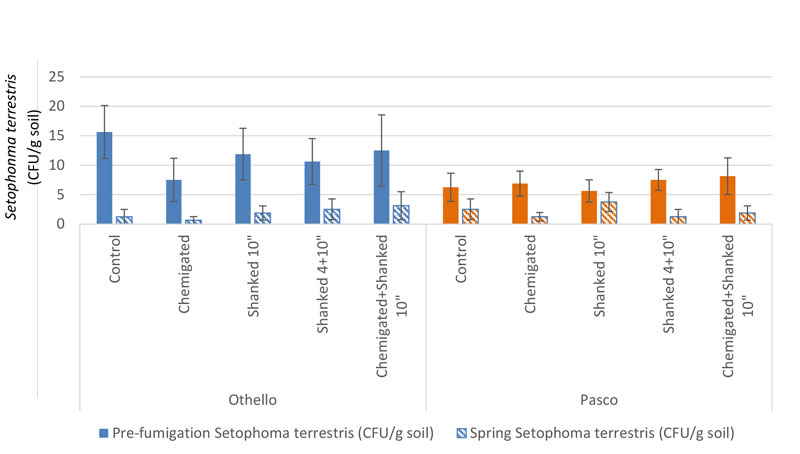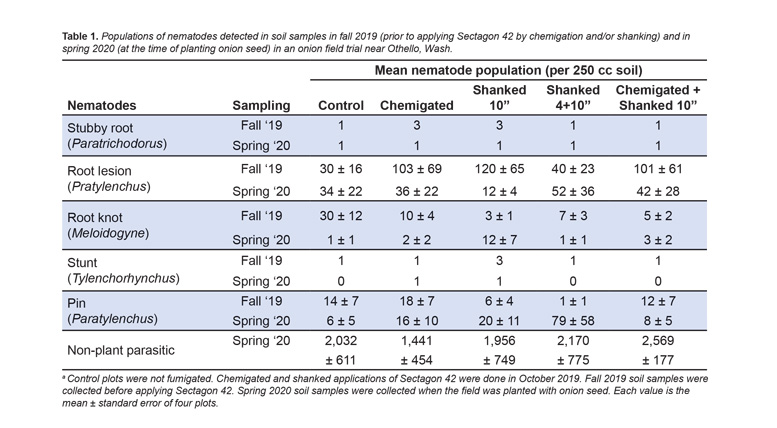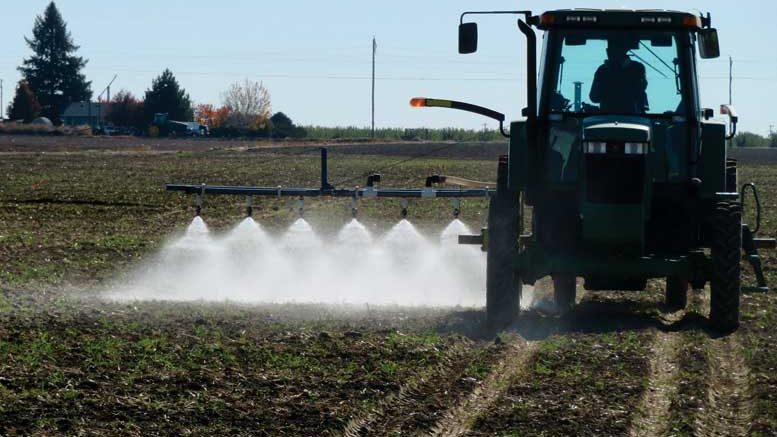Evaluating Methods of Application of Metam Sodium for Onion Production in the Columbia Basin
By Lindsey du Toit, Plant Pathologist, and Tim Waters, Regional Vegetable Extension Specialist, Washington State University
Russ Ingham, Oregon State University nematologist, demonstrated an economic benefit of applying oxamyl (Vydate) to onion fields in the Columbia Basin (central Washington and northcentral Oregon) that had stubby root nematode populations as low as 4 Paratrichodorus allius/250 g soil. However, there is no data on the effects of soil fumigation with metam sodium on stubby root nematode in onion production in this region. Metam sodium is used increasingly in the Columbia Basin to target multiple pests of onion, including the stubby root nematode, weeds and soil-borne diseases such as pink root (caused by Setophoma terrestris) and Fusarium basal rot (caused by Fusarium oxysporum f. sp. cepae).
Metam sodium typically is applied by chemigation through center pivots or by shanking to one or more depths. However, the method of application has a major influence on the location of metam sodium in the soil profile as the product has extremely poor vapor pressure and, therefore, poor mobility in soil. In other words, it must be placed physically where the target pest is located to be effective.
Most pink root and Fusarium basal rot inoculum is in the top 8-12 inches of the soil, whereas the weed seed bank that contributes to weed pressure in a crop is in the top 2-4 inches. Stubby root nematodes, in contrast, are migratory ectoparasites that feed externally on the tips of onion roots and migrate up or down the soil profile depending on soil temperature and moisture. The nematodes move as deep as 24 to 48 inches during the heat of summer in the Columbia Basin.
Objective
The objective of a recent study was to evaluate the effect of chemigated versus shanked applications of metam sodium for control of stubby root nematode (Paratrichodorus spp.), pink root (Setophoma terrestris), Fusarium basal rot (Fusarium oxysporum f. sp. cepae) and weeds in onion crops. The results will help clarify appropriate methods of application to get the best results when using metam sodium to control specific pests of onion in the Columbia Basin.
Field Trials
A trial was set up in each of two fields in the Columbia Basin in the fall of 2019, based on pre-fumigation sampling of fields on a 2-acre-grid basis by the growers: 1) a field near Pasco, Washington, with a soil pH of 6.2 and that was infested with 65 CFU of S. terrestris/500 g soil; and 2) a field near Othello, Washington, with a soil pH of 7.4 and that was infested with 120 and 540 stubby root and root lesion nematodes/500 cc soil, respectively. Soil sampled 12 inches deep from each of the 20 plots (25 cores/plot) in each trial in early October 2019 was used to determine the baseline population of the pink root pathogen and nematodes in each plot prior to fumigation.
Each trial was set up as a randomized complete block design with four replicate blocks of five metam sodium treatments:
- no metam sodium,
- simulated chemigation (1-2 inches deep),
- single shank injection ~10 inches deep,
- double shank injection at 4- and 10-inch depths, and
- chemigated (treatment 2) + shanked (treatment 3) applications.
Each plot in each trial was 30 feet x 150 feet. Fumigation treatments were done in Pasco on Oct. 7, 2019, and in Othello on Oct. 24, 2019. Sectagon 42 was applied at 40 GPA with the chemigation simulator (Fig. 1, see above) using 0.75 inches of water. For treatment 5, the same procedure was used with 20 GPA Sectagon 42 applied by chemigation + 20 GPA with a commercial shank applicator 10 inches deep. The commercial shank applicator is 28 feet wide (Fig. 2). Treatments 3 and 4 were applied with the commercial shank applicator, and half of treatment 5 was applied with this apparatus.

Approximately 40 hours after fumigation, Kyle Coleman of NovaSource used a MiniRae 3000 photo-ionization detector to measure the amount of metam sodium at each of seven 2-inch increments from 2 to 14 inches deep, at each of 10 2-inch increments horizontally, for 70 measurements per plot (Fig. 3). The amount of metam sodium detected (parts per million = ppm) and percentage of product detected at each of the 70 grid locations varied among treatments.

At the Pasco trial, a majority of metam sodium was at the 4-inch depth in chemigated plots, whereas shank applications distributed metam sodium more evenly across the soil profile from 6 to 10 inches deep. More metam sodium was detected in the soil profile in plots with shank applications compared to plots with chemigation alone.
At the Othello trial, soil moisture was at ~80 percent saturation during fumigation, which was closer to the recommended soil moisture level for effective fumigation than the 50 percent soil moisture content at the Pasco trial during the Sectagon 42 applications. This resulted in greater metam sodium readings in chemigated plots overall at Othello compared to Pasco. Metam sodium levels in plots with chemigated + shanked applications were at least four times greater in the Othello trial than the Pasco trial. This shows the importance of adequate soil moisture during fumigation with metam sodium to increase efficacy of applications, particularly by chemigation.
Soil was sampled from each plot in each trial again in spring 2020, shortly after each field was planted with onion seed by the grower, to assess residual impacts of fall fumigation treatments on pink root and nematode populations at planting. The incidence of broadleaf and grass weed control was rated on April 27, 2020, in Pasco and April 29, 2020, in Othello, and the incidence and severity of pink root and Fusarium basal rot were rated on July 23, 2020, in Pasco and Aug. 6, 2020, in Othello for 40 to 50 bulbs from each plot in each trial.

Results
Soil-borne inoculum of the pink root pathogen, S. terrestris, measured in fall 2019 prior to applying the Sectagon 42 treatments, averaged 11.6 CFU/g in the Othello trial and 6.9 CFU/g in the Pasco trial. In both trials, there was a significant decline in soil-borne inoculum by spring of 2020, regardless of fumigation treatment. Compared to non-fumigated control plots, none of the methods of applying Sectagon 42 reduced inoculum of S. terrestris (Fig. 4), and none reduced the percentage (incidence) of bulbs that developed pink root or the severity of pink root (Fig. 5). Similarly, none of the methods of applying Sectagon 42 reduced the percentage (incidence) of bulbs with Fusarium basal rot or the severity of Fusarium basal rot (Fig. 6).


Grass weed pressure was minimal in both trials in late April. In the Othello trial, none of the fumigation treatments reduced broadleaf weed pressure compared to non-fumigated control plots (Fig. 7). In fact, broadleaf weed pressure was greater in plots shanked 10 inches deep with Sectagon 42 compared to control plots. In contrast, plots shanked with Sectagon 42 at 10 inches or at 4-inch + 10-inch depths had fewer broadleaf weeds than chemigated plots (Fig. 7). Combined chemigation and shanking of Sectagon 42 did not improve weed control compared to shanking alone in the Pasco trial.

Very low populations of stubby root nematode were detected in the pre-fumigation soil samples at the Othello trial (1 to 3 nematodes/250 cc soil) despite the trial being located in a 2-acre section of the field that had high enough numbers of this nematode several months earlier to be damaging to onions (Table 1). Root lesion nematodes also were too low to be damaging to onion plants (30 to 120 nematodes/250 cc soil), and similarly for root knot, stunt and pin nematodes.

However, in June 2020, distinct patches of stunted plants were observed in the Othello field, caused by stubby root and lesion nematodes (18 and 153/250 cc soil, respectively). The distribution of stunted patches made it difficult to assess efficacy of the treatments against nematodes, but there was no evidence that any of the methods of Sectagon 42 application provided nematode control based on some of the large patches crossing over multiple plots (Fig. 8). Very few plant parasitic nematodes were detected in the Pasco trial (Table 1).

Overall, the results indicated very limited to no efficacy of the chemigated and shanked applications of Sectagon 42 for control of weeds, pink root, Fusarium basal rot and nematodes under the conditions of these trials. The low levels of some of these pests in one or both trials limited the ability to assess efficacy of the applications against those problems.
Soil moisture at the time of application had a very big influence on concentration and distribution of the fumigant in the soil profile. Ideally, soil should be maintained at about 80 percent soil moisture for several weeks prior to fumigation, along with good soil preparation to improve distribution of metam sodium in the soil profile.
This research was funded by the Columbia Basin Onion Research Committee, Washington State Commission for Pesticide Registration and Washington State University Hatch Project No. WNP00010.


